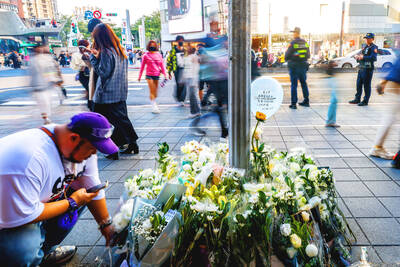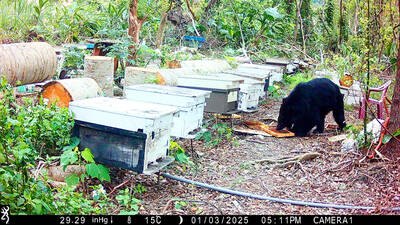Besides traditional sightseeing tours that take visitors to Sun Moon Lake and the mountainous region of Alishan (阿里山), the nation is also drawing tourists that are seeking to become healthier and more physically attractive.
In Hualien, an area traditionally known more for its coastal scenery than medical services, 67 medical institutions and travel operators recently started offering high-end medical packages aimed at Chinese tourists.
Priced at NT$500,000, the seven-day package features a combination of Western-style physical checkups and clinical cosmetology, as well as Chinese preventive medicine.
A 14-day package features even higher-end healthcare and anti-aging treatment for double the price, according to a county international medical tourism association established by the local government.
The Buddhist Tzu Chi General Hospital in Hualien also offers interesting services in the field of medical tourism.
The hospital made a name for itself by making people’s legs slimmer through a calf muscle trimming procedure, which has been drawing tourists from as far as Brazil.
Since 2001, the hospital has conducted the procedure on 500 people.
Of all the medical tourists visiting the hospital, 20 percent are from China, Hong Kong, Macau, the US, Canada and Japan.
What is happening in Hualien is part of a larger development across the nation, where policymakers are increasingly attaching importance to medical tourism as a new niche market and a way to boost the country’s economy.
According to the Taiwan External Trade Development Council (TAITRA), the nation’s top trade promoter, Taiwan received 81,462 medical tourists by the end of the third quarter of last year, more than double the 39,428 visitors who came in 2011.
Among those treated last year, 60 percent came for treatment, 27 percent for health check-ups and 13 percent for cosmetic surgery, TAITRA said.
In December last year, Minister without Portfolio Kuan Chung-ming (管中閔) proposed setting up a “service industry experimental zone” near Taiwan Taoyuan International Airport that would offer “derivative services from tourism.”
The “derivative services” could include the travel, shopping, clinical cosmetology and financial services sectors and would cater to the needs of international visitors.
Kuan said the idea was part of efforts aimed at boosting employment by cultivating the service industry.
The Council for Economic Planning and Development also floated the idea of “free economic demonstration zones” that would foster the transformation of Taiwan into a regional hub of critical medical care and medical tourism, industrial innovation, international logistics, global talent training and agricultural product sales.
Meanwhile, the nation has been striving to attract more medical tourists from China, given the two countries’ linguistic and cultural similarities, observers said.
According to TAITRA, 3 million people undergo plastic surgery in China every year.
The market for cosmetic surgery in China has grown by 10 percent annually and had surpassed the global average of 6 percent, TAITRA said. Taiwan also launched a 15-day medical tourism visa in January last year to cater to Chinese tourists.
In August last year, the government also promoted an e-visa service to make it easier for Chinese tourists to visit Taiwan for physical checkups, cosmetic surgery or anti-aging treatments.
Taiwan received a total of 50,376 medical tourists from China last year.

SHIPS, TRAINS AND AUTOMOBILES: The ministry has announced changes to varied transportation industries taking effect soon, with a number of effects for passengers Beginning next month, the post office is canceling signature upon delivery and written inquiry services for international registered small packets in accordance with the new policy of the Universal Postal Union, the Ministry of Transportation and Communications said yesterday. The new policy does not apply to packets that are to be delivered to China, the ministry said. Senders of international registered small packets would receive a NT$10 rebate on postage if the packets are sent from Jan. 1 to March 31, it added. The ministry said that three other policies are also scheduled to take effect next month. International cruise ship operators

HORROR STORIES: One victim recounted not realizing they had been stabbed and seeing people bleeding, while another recalled breaking down in tears after fleeing A man on Friday died after he tried to fight the knife-wielding suspect who went on a stabbing spree near two of Taipei’s busiest metro stations, Taipei Mayor Chiang Wan-an (蔣萬安) said. The 57-year-old man, identified by his family name, Yu (余), encountered the suspect at Exit M7 of Taipei Main Station and immediately tried to stop him, but was fatally wounded and later died, Chiang said, calling the incident “heartbreaking.” Yu’s family would receive at least NT$5 million (US$158,584) in compensation through the Taipei Rapid Transit Corp’s (TRTC) insurance coverage, he said after convening an emergency security response meeting yesterday morning. National

PLANNED: The suspect visited the crime scene before the killings, seeking information on how to access the roof, and had extensively researched a 2014 stabbing incident The suspect in a stabbing attack that killed three people and injured 11 in Taipei on Friday had planned the assault and set fires at other locations earlier in the day, law enforcement officials said yesterday. National Police Agency (NPA) Director-General Chang Jung-hsin (張榮興) said the suspect, a 27-year-old man named Chang Wen (張文), began the attacks at 3:40pm, first setting off smoke bombs on a road, damaging cars and motorbikes. Earlier, Chang Wen set fire to a rental room where he was staying on Gongyuan Road in Zhongzheng District (中正), Chang Jung-hsin said. The suspect later threw smoke grenades near two exits

The Forestry and Nature Conservation Agency yesterday launched a gift box to market honey “certified by a Formosan black bear” in appreciation of a beekeeper’s amicable interaction with a honey-thieving bear. Beekeeper Chih Ming-chen (池明鎮) in January inspected his bee farm in Hualien County’s Jhuosi Township (卓溪) and found that more than 20 beehives had been destroyed and many hives were eaten, with bear droppings and paw prints near the destroyed hives, the agency said. Chih returned to the farm to move the remaining beehives away that evening when he encountered a Formosan black bear only 20m away, the agency said. The bear